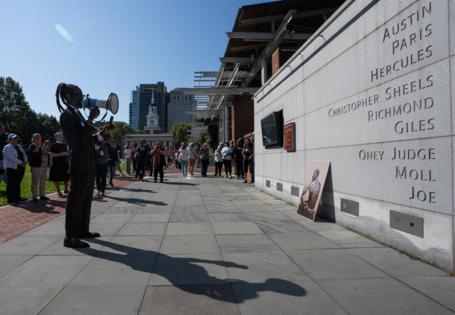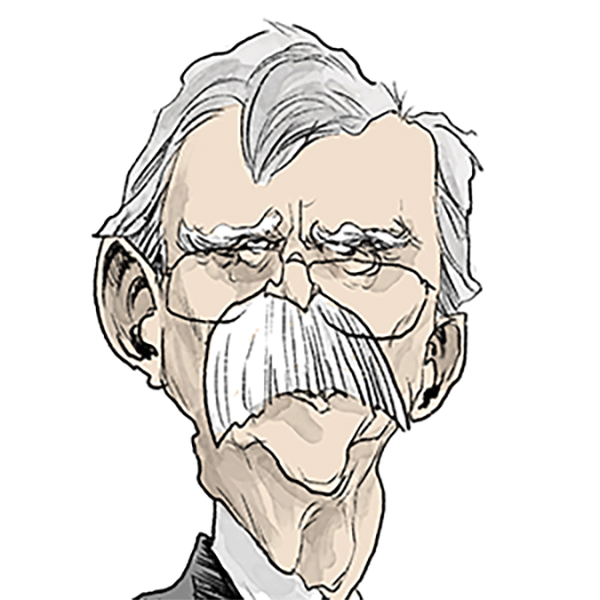Trump's interior secretary visits Independence Park as crowd silently protests his attempt to 'whitewash' slavery exhibits
Published in News & Features
PHILADELPHIA — Under the glaring sun, dozens of people stood in a semicircle near Independence National Historical Park’s President’s House Site, bowed their heads, and gathered in silence for nine minutes Friday morning.
The moment of quiet protest was held as Interior Secretary Doug Burgum visited the park, mere days after reports emerged that his department plans to alter the President’s House Site, which memorializes the nine people George Washington enslaved in Philadelphia and outlines the contrasting stories of liberty and slavery during the founding of America.
“What can’t occur is slavery being censored in this historical place. We must show the harm,” Michael Coard, an attorney and leader of Avenging the Ancestors Coalition, or ATAC, which organized the protest, said into a megaphone ahead of the moment of silence.
It remains unclear what changes could be made to the site, triggered by directives from Burgum and President Donald Trump.
As of Friday morning, exhibits at the President’s House appeared untouched.
The Interior secretary joined Transportation Secretary Sean Duffy at Independence Park Friday for private meetings in preparation for celebrations of the 250th anniversary of the United States in 2026.
The 250th is expected to boost tourism in the city, especially to its historic sites and — despite his administration looking to sanitize parts of American history there — Trump has ordered more funding to improve the infrastructure of Independence Park.
A spokesperson for the Interior Department did not immediately return a request for comment on Burgum’s visit.
But the likely celebratory nature of the Cabinet secretaries’ visit came in stark contrast to the heavy emotions that advocates were experiencing Friday, even if demonstrators did not come in contact with the officials.
Coard is still hoping to engage the interior secretary.
“We’ve got a letter for him we’d like him to read, requesting a meeting with park officials about the Washington site,” Coard told The Philadelphia Inquirer.
Once the nine minutes of silence came to a close, many people lingered, hugging and exchanging phone numbers. A few stood, tearful, near the nine names of the people Washington had enslaved chiseled into a stone wall at the site.
“I need to memorize their names,” said Olaniyan Adefumi, 67, a retired Philadelphia schoolteacher from Nicetown. “They can’t erase that part of Black history from my mind.”
The threats to the President’s House Site, which opened in 2010 and was developed after years of advocacy from ATAC, has ignited local advocacy in the form of demonstrations, written statements, and a public town hall.
And Philadelphia City Council President Kenyatta Johnson introduced a resolution Thursday condemning Trump’s efforts to “whitewash” U.S. history.
Johnson told reporters that he has not ruled out an option to relocate exhibits from the President’s House should they be removed by the Trump administration. Visit Philadelphia, the city’s top tourism group, offered the same.
Mounting concern over the fate of the President’s House and other exhibits on slavery at Independence Park began this summer after park staff flagged more than a dozen exhibits at the park for the Trump administration’s content review.
The review, as ordered by Trump and Burgum, sought to identify content for removal that “inappropriately disparages Americans past or living.”
In addition to 13 items across six exhibits flagged at the President’s House, park staff also marked materials at the Benjamin Franklin Museum, the Second Bank, Independence Hall, an outdoor wayside exhibit panel on Independence Mall, and a proposed redesigned exhibit.
“It means we’re not only saying they didn’t exist, we’re saying they didn’t participate in America’s greatness, didn’t contribute to its wealth and grandeur,” said Michelle Flamer, a former attorney for the city of Philadelphia who is a part of Coard’s coalition.
“We were here, and we’re still here,” Flamer added.
It’s been a rallying call for not only local advocates but also for visitors.
Kelly McKee, 59, a university administrator from Seattle, had read people’s protest signs at the site on Friday, after having arrived here earlier in the week on vacation. She said she needed to be a part of it.
“It’s important that we maintain an accurate account of history so we can change the future and not let things like slavery happen again,” she said.
Overhearing McKee, Tim Merrill, 65, a minister at Imani Community Fellowship church in Camden, nodded and said, “So many people in Camden don’t even know how slaves were auctioned there, right on the river.”
“I’m here in solidarity with these guys protesting,” he added. “The stories of this country can’t be sacrificed to President Donald Trump’s fear of the truth.”
©2025 The Philadelphia Inquirer. Visit inquirer.com. Distributed by Tribune Content Agency, LLC.







Comments